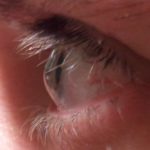 Scleral lenses have been around for over 100 years. Until the new gas permeable lens materials were developed patients could only wear scleral lenses for a few hours a day. With the highly oxygen permeable lens materials now in use, patients can comfortably wear these lenses all day. Scleral contacts are most commonly used to treat eyes with irregular corneas such as keratoconus and post-surgical eyes (usually following corneal transplant surgery or related to complications from refractive surgery). Another common use for scleral contact lenses is in the special effects industry where they are used to protect the cornea and/or to give the eye an exotic appearance.
Scleral lenses have been around for over 100 years. Until the new gas permeable lens materials were developed patients could only wear scleral lenses for a few hours a day. With the highly oxygen permeable lens materials now in use, patients can comfortably wear these lenses all day. Scleral contacts are most commonly used to treat eyes with irregular corneas such as keratoconus and post-surgical eyes (usually following corneal transplant surgery or related to complications from refractive surgery). Another common use for scleral contact lenses is in the special effects industry where they are used to protect the cornea and/or to give the eye an exotic appearance.
What Is A Scleral Lens?
Scleral contacts are large contact lenses that rest on the sclera (white part of the eye) with the remainder of the lens vaulting over the cornea. Tears are trapped between the lens and the cornea allowing scleral contacts to treat irregular corneas. Scleral contact lenses are also used to treat dry eye syndrome by preventing the cornea from drying out. The average soft contact lens has a diameter of about 14 mm whereas scleral contacts typically have a diameter exceeding 14.5 mm. The larger diameter is one of the biggest reasons why scleral contacts are so comfortable.
How Are Scleral Lenses used?
At Total Eye Care, Dr. Driscoll has used scleral contact lenses to treat many conditions such as irregular astigmatism, keratoconus, high myopia, dry eye syndrome, and complications related to LASIK and PRK. Because of their size, sclerals are quite comfortable. Patients often report the comfort being similar to that of a soft contact lens. Most patients with irregular corneas will see better with a scleral lens than with glasses.
Below is a good video that shows how scleral contacts are cared for and how to insert and remove them.

